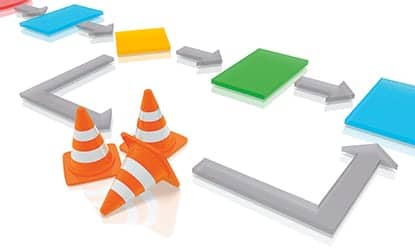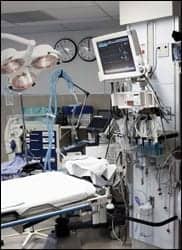
While CMS reconsiders its directive regarding maintenance procedures, the industry looks beyond the roadblock to address the development of standards for its evidence-based practices.
By Renee Diiulio
On December 2, 2011, the Centers for Medicare and Medicaid Services (CMS) released a clarification of hospital maintenance requirements that contradicted what the majority of clinical/biomedical engineering departments have been doing. The move took many by surprise, seeming to come from nowhere. And, in fact, the directive was not linked to a specific incident involving a medical device failure or equipment system failure, but it did initiate from confusion related to conflicting standards. CMS believed it was helpfully addressing an issue.
The situation was presented by a facility that had been surveyed by two different accrediting organizations, but only met the criteria for one of the entities. A query to CMS alerted the regulatory body that the accrediting organizations were utilizing different standards. So it looked into the issue and released the clarification. The content was short but impactful. It stated that hospitals can adjust the maintenance, inspection, and testing frequencies from the manufacturers’ recommendations, but only for noncritical equipment with a sufficient amount of maintenance history. All equipment critical to patient health and safety is required to be maintained according to the manufacturers’ recommendations; and alternative maintenance methods are not permitted. (See official memorandum summary in the sidebar below.)1
The dismayed response from the clinical and biomedical engineering community was not what CMS expected. “CMS thought they were doing a good thing when they gave us the clarification that it’s OK to vary from the manufacturers’ recommendations on nonmedical equipment,” says Karen Waninger, director of clinical engineering for the Community Health Network in Indianapolis, and a member of the Association for the Advancement of Medical Instrumentation (AAMI) Technology Management Committee.
However, the implication for a discipline that has already been implementing evidence-based procedures has a potentially much greater negative impact than CMS expected. “The primary objection of the health care technology management profession is that it would increase the cost of health care dramatically for health care organizations with in-house departments that perform maintenance,” says Mary Logan, AAMI president.
So industry associations and leaders initiated discussions with a receptive CMS. “CMS did not know initially who to ask whether their approach made sense,” Logan says. “Now, they know that AAMI exists and we would be delighted to give them data to help them make decisions, and they have taken us up on that.”
The governing body is now revisiting the issue armed with information in the form of a 244-page packet submitted by AAMI and the American Society for Healthcare Engineering (ASHE). The data provides details on the methods in place at many facilities and addresses questions raised by CMS during previous meetings.
While CMS reviews the material and its requirements, facilities are faced with meeting manufacturer recommendations or rolling the dice. CMS has granted both DNV, part of Det Norske Veritas, Oslo, Norway, and The Joint Commission approval to continue to survey under the same process they had been using prior to the December 2011 clarification. “So if you are accredited by DNV or The Joint Commission, nothing has to change. But CMS examines 5% of all facilities as a random direct CMS survey, and in the event that you are one of those random surveys, you may be held accountable for the literal manufacturer recommendations on critical equipment,” Waninger says.
While the citation may not require corrective action, CMS has been vague regarding any consequences. However, health care organizations and industry associations are hoping that CMS will revise its recommendations to fall more in line with what facilities are doing today rather quickly—though with some standardization requirements.
Lots of Evidence, Few Standards
It is the lack of standardization that motivated CMS to examine the issue initially. “Today, everybody has their own process for tracking evidence and adjusting procedures and intervals,” Waninger says.
However, many facility protocols share an evidence-based philosophy. Guiding associations utilize these methods as well. “The maintenance strategies provided by AAMI and ASHE are similar, using a risk-based approach grounded in evidence accumulated over time,” says Dale Woodin, ASHE executive director.
CMS noted in the December 11 document that “several maintenance strategies (eg, preventive, predictive, reactive, and reliability-centered) can be used to determine the appropriate frequency for maintenance, inspection, and testing of equipment, based upon acceptable risk to patient health and safety.” However, the organization also noted “the content of the recommended maintenance activities must not be substituted or eliminated.”
While rooted in the objective of reducing patient risk, many believe the CMS requirements are misguided and potentially far more expensive in terms of resources. “Our primary concern is [that] this will drive up the cost of providing equipment services [while] ignoring proven risk-based strategies developed with the intent to provide appropriate testing and maintenance service to equipment that would benefit from such service and not render that same service to equipment where no benefit is derived,” Woodin says. “Hospital resources are scarce, and we simply cannot afford to invest time and energy into activities that do not benefit patient care.”
He notes that many of the strategies offered by AAMI and ASHE have been in compliance with the standards of The Joint Commission, and that a review of medical device incidents in the FDA Manufacturer and User Facility Device Experience (MAUDE) system has substantiated the effectiveness of the approach. “ASHE has published three editions of recommended practices for inspection, testing, and maintenance of facilities equipment and systems, with each subsequent edition building on the evolving body of knowledge and practice,” Woodin says.
Individual programs are then able to take into account facility-specific factors, such as device history and use. “In some cases, it makes sense to expand the interval between maintenance and perform it less often or, in other cases, to do it more often,” Waninger says. And this holds whether the equipment is classified as critical or noncritical.
An Optimistic Future
Subsequently, the industry has proposed that CMS reconsider its ruling. “We asked that they consider eliminating the restriction to noncritical medical equipment only and to consider alternative maintenance procedures to be acceptable as long as there is evidence that the procedures have been effective,” Waninger says.
Information the organization requested to help make its decision covers details such as common algorithms and methodologies used to determine maintenance methodologies or frequencies, existing guidance in use by the field, examples of evidence-based maintenance and equipment history documentation, and estimates of the impact of the CMS letter on the field.
“We don’t know what CMS will do, but we think it’s a good sign that they have cared enough to ask, listen, and take our information into consideration before they really finalize anything,” Logan says.
If CMS does release requirements more in line with what departments are doing today, things will return to “normal” or near normal for most organizations. Biomedical/clinical engineering departments should already be keeping data and documentation on their procedures and protocols. “Health care organizations need to perform a careful analysis, and if their approach varies from the manufacturers’ recommendations, they need to carefully document why—even if CMS were to never visit the hospital—because the ultimate goal is patient safety,” Logan says.
Over the longer term, guidelines can be expected to be developed, leading to consistent standards across all of the accrediting bodies. Waninger believes adoption would not be difficult. “The organizations I have spoken with are in favor of standards, and I believe the majority of them would be very willing to participate,” Waninger says.
She notes that efforts have already begun, and it is possible standards could be completed within 2 years—though she allows that this is an optimistic time frame, the optimism is not necessarily misplaced.
Most health care technology management departments are already relying on evidence-based, or risk-based, maintenance and service programs for their medical equipment. Many programs may already address the concerns expressed by CMS, lending further hope to a revision of the directive. And, a majority of involved organizations are receptive to the development of industry standards. The reason, according to Waninger, is simple: “CMS has the same objective we do, which is to manage patient risk and protect patients in the safest and most financially responsible way.” Nothing can be clearer than that. 24×7 Feature Article, December 2012.
Renee Diiulio is a contributing writer for 24×7. For more information, contact [email protected].
The Full Scoop
If you have not read the Centers for Medicare and Medicaid December 2011 directive changing the requirements for biomedical equipment maintenance, here is your chance to get the scoop. Read the official summary below.
Memorandum Summary of the CMS Clarification of Hospital Equipment Maintenance Requirements:
Alternate equipment maintenance schedules permitted in some instances: Hospitals may adjust maintenance, inspection, and testing frequencies for some facility and medical equipment below those recommended by the manufacturer, based on an assessment by qualified personnel of the risk to patient and staff health and safety.
Manufacturer recommended maintenance frequency is required for:
1) All equipment critical to patient health and safety; and
2) Any new equipment until a sufficient amount of maintenance history has been acquired.
Alternative equipment maintenance methods are not permitted: Hospitals must continue to follow the manufacturer’s recommended techniques for maintaining equipment, even if the hospitals alter the frequency of maintenance activities.
—RD
Reference
1. Clarification of hospital equipment maintenance requirements. Office of Clinical Standards and Quality/Survey and Certification Group, Department of Health and Human Services, Centers for Medicare and Medicaid Services. December 2, 2011.



